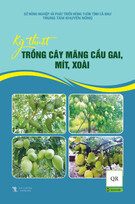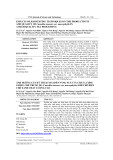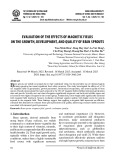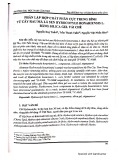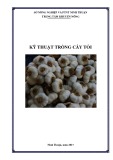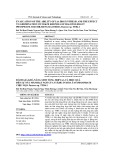
Vietnam Journal
of Agricultural
Sciences
ISSN 2588-1299
VJAS 2024; 7(2): 2099-2109
https://doi.org/10.31817/vjas.2024.7.2.01
https://vjas.vnua.edu.vn/
2099
Received: May 15, 2023
Accepted: May 23, 2024
Correspondence to
ntloan@vnua.edu.vn
Integration of Mineral Fertilizer with Organic
Fertilizer for Improved Tomato Fruit Yield
and Quality
Nguyen Thi Loan1*, Nguyen Ngoc Hung2, Tran Thi Thiem1 &
Thieu Thi Phong Thu1
1Faculty of Agronomy, Vietnam National Univerisy of Agriculture, Hanoi 131000, Vietnam
2Hybrid Rice Research and Development Center, Field Crops Research Institute, Hanoi
134000, Vietnam
Abstract
This study aimed to evaluate the effects of chemical and organic
fertilizers in different fertilization regimes on vegetative growth, fruit
yield, and fruit quality of tomatoes. The experiment was arranged in
a randomized complete block design with three replications in the
winter season of 2021. The treatments were: no fertilizers,
application of NPK fertilizer (15-15-15) at a rate of 1000 kg ha-1,
application of chicken manure at a rate of 12 tons ha-1, and three
treatments of the combination of NPK fertilizer and chicken manure
at the ratios of 70:30, 50:50, and 30:70, respectively. The results
indicated that the combination of chemical and organic fertilizers led
to improved vegetative plant growth. Combining 70% of NPK
fertilizer with 30% of chicken manure gave the maximum fruit yield
component values and fruit yield of tomatoes. Adding chicken
manure to the fertilization regimes also led to better fruit quality. The
integrated fertilization increased the TSS and vitamin C values, and
when 50-70% of the chemical fertilizers were substituted with
chicken manure, the sugar content and total acid increased in the
fruits. The color at the red stage was more intense in tomato fruits
treated with the NPK fertilizer and integrated fertilization regimes
compared to those from organic fertilization.
Keywords
Tomato, integrated nutrient management, organic fertilizer, tomato
fruit quality, tomato fruit color
Introduction
Nutrient and fertilizer management has played an important role
in providing sufficient and nutritious food for the continually
growing human population as well as sustaining environmental
quality (Ishfaq et al., 2023). Nutrient management means managing
all possible nutrient sources, including chemical fertilizers, organic

Integration of mineral fertilizer with organic fertilizer for improved tomato fruit yield and quality
2100
Vietnam Journal of Agricultural Sciences
manures and waste materials suitable for
recycling nutrients, and biofertilizers, in such a
way that crop yield is maintained sustainably to
meet human demands, and to enhance the quality
of land and water resources (Singh & Singh,
2001). Inorganic fertilizers improve crop yield
and productivity, but their long-term use poses
negative effects on soil health and the
environment (Sarwar et al., 2021). On the other
hand, Islam et al. (2017) reported that the
continuous application of organic sources
improves crop performance as well as soil
organic matter and soil quality. However,
organic fertilizers act as slow-release fertilizers
with lower contents of nutrients, which can cause
to insufficient crop nutrient requirements during
the growing period (Shaji et al., 2021).
Therefore, organic farming cannot increase crop
yield within short time periods as compared to
chemical fertilizers (Islam et al., 2017; Sarwar et
al., 2021). Nowadays, integrated nutrient
management is considered to be a sustainable
option to improve soil health and crop yields
(Ishfaq et al., 2023).
An integrated nutrient management system
is characterized by a combination of synthetic
and organic fertilizers, and has been revealed to
be responsible for higher crop yields and reduced
fertilizer pollution (Mamia et al., 2018). Many
studies have shown that mixing fertilizer
applications leads to an enhanced efficiency of
chemical fertilizers by reducing nutrient losses
and, maintaining soil nutrient balance, which
results in an increase of crop growth, yield
attributes, and yield as compared with using
inorganic or organic fertilizer alone (Mamia et
al., 2018; Ghosh et al., 2022). Besides,
combining organic with inorganic fertilizers
often leads to soil improvement through
increased soil organic matter content, improved
soil structure, water holding capacity, and
nutrient cycling, and helps maintain the soil
nutrients status, cation exchange capacity, and
soil biological activity (Islam et al., 2017; Liu et
al., 2021). Ghosh et al. (2022) showed that
combining organic manures with chemical
fertilizer effectively inhibited nutrient removal,
which significantly enhanced rice yield by 10%
along with a 3-7% higher nutrient uptake. Khan
et al. (2017) concluded that maximum yield
components and fruit yield, and the best NPK
uptake by tomato plants were obtained under a
full dose of chemical fertilizers alongside the
application of compost. Ndengu et al. (2022)
showed that bush bean yields could be enhanced
by the combined application of organic and
inorganic fertilizers in intercropped maize and
beans. According to Mahmood et al. (2017), the
growth and yield of maize were substantially
improved by chemical fertilizer application
alongside organic manures whereas soil total
organic C and total NPK contents increased when
inorganic fertilizers were applied alone or in
combination with organic manures.
Tomato (Lycopersicon esculentum Mill.)
constitutes one of the most valuable horticultural
crops, not only because of its economic
importance, but also for its sensory qualities and
nutritional value. Tomato fruits are rich in
vitamins, minerals, and protein, and contain
many organic acids and major antioxidants such
as lycopene, phenolics, and vitamin C (Ali et al.,
2021). The worldwide tomato production and
planting area reached 189.28 million tons and
5.05 million hectares, respectively in 2021
(FAOSTAT, 2021). In Vietnam, in 2019, the
planting area of tomatoes was 23.791 thousand
ha, with a productivity of 673,194.5 tons, and the
average fresh fruit yield was 28.3 tons ha-1 (Doan
et al., 2021), which was still low as compared to
the world average (36.42 tons ha-1, according to
FAOSTAT (2019)). Soil fertility degradation in
Vietnam caused by overuse and low use
efficiency of chemical fertilizers has been
considered as one of the most probable reasons
associated with decreased crop yields and
quality. According to Cassou et al. (2017),
annually, Vietnam uses approximately 11 million
tons of fertilizers, of which inorganic fertilizers
account for 90%. However, fertilizer use
efficiency is very low, around 30-45% for
nitrogen, 15-25% for phosphorus, and 40-50%
for potassium (Tran et al., 2012). Therefore, poor
soil fertility with low organic matter needs
much attention for sustainable crop production,
and integrated nutrient management is
essential for the existing and prospective
cropping systems in Vietnam.

Nguyen Thi Loan et al. (2024)
https://vjas.vnua.edu.vn/
2101
Keeping all these aspects in consideration,
the present study was therefore conducted to
evaluate the effects of organic and inorganic
fertilizers alone and their integration on tomato
vegetative growth, fruit yield, and quality.
Materials and Methods
Treatments and experimental design
The field experiment with tomato variety F1
Pear was conducted in the winter-spring season,
from October 2021 to February 2022, at the
experimental site of the Faculty of Agronomy,
Vietnam National University of Agriculture
(Hanoi, Vietnam). The soil before the experiment
was found to be neutral soil (pH = 6.63, TCVN
5979:2007) containing 2.31% of organic matter
(OM) (TCVN 8941:2011), 0.13% of total N
(TCVN 6498:1999), 3.86mg/100g of soil of
available nitrogen (TCVN 5255:2009), 16.84
mg/100 g of soil of exchangeable P2O5 (TCVN
8942:2011), and 8.62 mg/100 g of soil of
exchangeable K2O (TCVN 8662:2011). The
fertilizers used in the experiment were a
compound chemical fertilizer with an N-P-K
ratio of 15-15-15, and chicken manure (CM) with
the nutrient characteristics of OM = 33.95%
(TCVN 9294:2012), 1.25% of total N (TCVN
8557:2012), 0.52% of total P2O5 (TCVN
8562:2010), and 0.63% of total K2O (TCVN
8562:2010).
The field experiment was laid out in a
randomized complete block design (RBCD) with
three replications. The treatments were as
follows: C – control (without fertilization);
NPK100 – application of NPK fertilizer at the rate
of 1000 kg ha-1; CM100 – application of chicken
manure at the rate of 12 tons ha-1; NPK70CM30 –
combination of 70% NPK fertilizer with 30%
CM; NPK50CM50 – combination of 50% NPK
fertilizer with 50% CM; and NPK30CM70 -
combination of 30% NPK fertilizer with 70%
CM. The rates of application of the chemical
fertilizer and CM in the fertilized treatments were
determined based on the principle that the total
applied N to the soil was equal to 150 kg N ha-1.
The chemical fertilizer was applied four
times: 50% before transplanting, 20% at the first
top dressing (7 days after transplanting - DAT),
15% at the first flowering stage, and 15% at the
first harvest. The CM was fully applied to the soil
surface one week before transplanting.
The dimensions of the individual treatment
plots were 5m x 1.2m. Twenty-five-day-old
seedlings of tomato (Cv. Pear F1) were
transplanted at a 60 x 45 cm spacing.
Recommended cultural practices such as
irrigation, removal of weeds, and plant protection
were adopted uniformly according to standard
crop management procedures. Weeds were
manually controlled.
Growth and development characteristics
Five randomly selected plants in each plot
were used to measure the growth indicators
(plant height and number of leaves) at two-week
intervals after planting until the last harvest.
The yield components (the number of fruits
per plant, average fruit weight, and fruit weight
per plant) were observed on five randomly
selected plants in each plot, and fruit yield was
measured by weighing the total number of
harvested fruits of all the plants in each plot.
Thirty marketable fruits were sampled
randomly from the harvest of each plot to
determine the fruit size (fruit height and fruit
diameter). Then, these fruit samples were dried
in an oven at 105oC to a constant weight to
determine the fruit dry weight. Another group of
20 ripe tomatoes was harvested in each plot and
analyzed for the following parameters: the total
soluble solids (TSS) (using hand refractometer),
sugar content (the Anthrone method), vitamin C
(the Iodine Titration method), and acidity (the
titration method).
Fruit surface color measurements (L*, a*,
b*) were performed with a Colorimeter
KONICA MINOLTA model CR – 400 (Japan).
Therein, L*, a*, and b* represent the three axes
of the CIELAB color space, with L* representing
lightness from black to white, a* showing the
fruit redness from green (negative value) to red
(positive value), and b* showing the yellowness
of fruits from blue (negative value) to yellow
(positive value) (Camelo & Gómez, 2004).
Color indices were computed by the following
formulas according to Bilalis et al. (2018):

Integration of mineral fertilizer with organic fertilizer for improved tomato fruit yield and quality
2102
Vietnam Journal of Agricultural Sciences
The color index (CI) shows a high
correlation with the external visual color of the
fruits and was calculated with the following
equation: CI = 1000a*L*-1b*-1
The hue angle (ho), the qualitative attribute
of color, is used to define the difference between
a certain color and a grey color with the same
lightness and was calculated with the following
equation: ho = tan-1(b*/a*)
Chrome (C*) represents the color saturation
and was determined using the equation:
C* = (a*2+ b*2)0,5
Color difference with true red (DE) relates to
the true red color and was determined using the
following equation:
DE = ((L*-50)2 + (a*-60)2+b*2)0.5
The a*/b* ratio can be used to report the
brightness of the red color of the tomato fruit and
its products.
Statistical analysis
Data were compared among treatments using
a one-way analysis of variance. Then, the
treatment means were subjected to pairwise
comparisons with Duncan’s multiple range test
using SPSS software version 20. Differences were
considered statistically significant at P <0.05.
Results
The effect of different fertilizer regimes on the
plant growth characteristics
From the results observed, the growth
indicators of the tomato plants were significantly
affected by the different fertilization treatments
at all measured times (Figure 1). The lowest
plant height and number of leaves were observed
under the no-fertilization treatment during the
growth period of tomato plants. The combined
application of organic and inorganic fertilizers
produced taller plants than that of the sole
application of inorganic fertilizer (NPK100). From
63 DAP onwards, the plant height in plots treated
with CM100 was statistically lower than those in
plots treated with NPK100 or combined
fertilization. For the number of leaves, there were
no significant differences between the integrated
fertilization with NPK100, or between the
integrated fertilization with CM100. At the final
harvest, the highest numbers of leaves were
found in plants treated with NPK100 and
NPK70CM30, which were significantly higher
than those treated with CM100.
The better plant growth under the
combination of organic and inorganic fertilizers
was probably due to the fact that in the plots
treated with NPK combined with CM, tomato
plants initially could use the available nutrients
from the chemical fertilizer and then the
available nutrients from the CM were released
through the mineralization process and combined
with the soil nutrients to support plant growth.
Ma et al. (2022) revealed that the application of
CM to the soil led to the increase of microbiota
and their activities in the soil, which
consequently improved the availability and
uptake of N and P, and released plant-promoting
substances, resulting in better plant vegetative
growth. Mengistu et al. (2017) reported
dramatically higher plant height and number of
leaves of tomato in plots treated with combined
fertilization compared to the sole addition of
chemical or organic fertilizers. In addition,
Laxmi et al. (2015) revealed the highest plant
height of tomato was under a combination of
50% organic and 50% inorganic fertilizers,
which was related to the improved soil fertility
and adequate nutrient supply to the plants. The
shortest tomato plant height was recorded in the
control plots, which was due to the non-
availability of nutrients (Laxmi et al., 2015;
Mengistu et al., 2017).
The effects of different fertilizer regimes on
the yield attributes and fruit yield of tomato
The effect of different fertilization regimes
on the number of fruits and fruit characteristics is
shown in Table 1. Fertilizer application resulted
in dramatically higher numbers of fruits as
compared to the control treatment. Higher
applications of NPK led to increased numbers of
fruits on tomato plants, therein the best value was
achieved under NPK50CM50, which was not
significantly different from NPK100 and
NPK70CM30. On the other hand, high-rate
applications of organic fertilizer (CM100 or
NPK30CM70) drastically decreased the number of

Nguyen Thi Loan et al. (2024)
https://vjas.vnua.edu.vn/
2103
Figure 1. Influence of different fertilizer regimes on the growth indicators of tomato
Table 1. Effect of different fertilizer regimes on tomato fruit characteristics and yield attributes
Treatments
Number of
fruits
(fruits plant-1)
Fruit weight
(g fruit-1)
Fruit characteristics
Fruit height
(cm)
Fruit diameter
(cm)
Fruit dry weight
(g fruit-1)
Fruit dry matter
(%)
Control
14.80d
68.58b
6.04
4.83b
2.30c
3.12
NPK100
23.67ab
75.13ab
6.24
5.17a
2.94ab
3.24
NPK 70CM30
22.53abc
77.36a
6.18
5.10a
2.63bc
3.55
NPK 50CM50
25.33a
76.39ab
6.14
4.94ab
3.11a
3.65
NPK 30CM70
19.67c
76.62ab
6.07
4.96ab
2.98ab
3.76
CM100
19.13c
73.98ab
6.14
4.96ab
2.64bc
3.37
Sig.
*
*
ns
*
*
-
CV(%)
18.17
4.31
1.09
2.22
7.89
-
Note: *Significant at the 5% level. ns non-significant; In a column, figures with same letter or without a letter did not differ significantly
whereas figures with dissimilar letters differed significantly.
fruits compared with the combined fertilization
treatments and the NPK100 treatment. There were
no statistical differences of fruit weights among
the fertilized treatments, but the fruits treated
with NPK70CM30 had a significantly higher
weight than those in the control treatment.
0
20
40
60
80
100
120
721 35 49 63 77 91 105
Plant height (cm)
Days after planting
0
5
10
15
20
25
30
721 35 49 63 77 91 105
Number of leaves (leaves plant-1)
Days after planting



